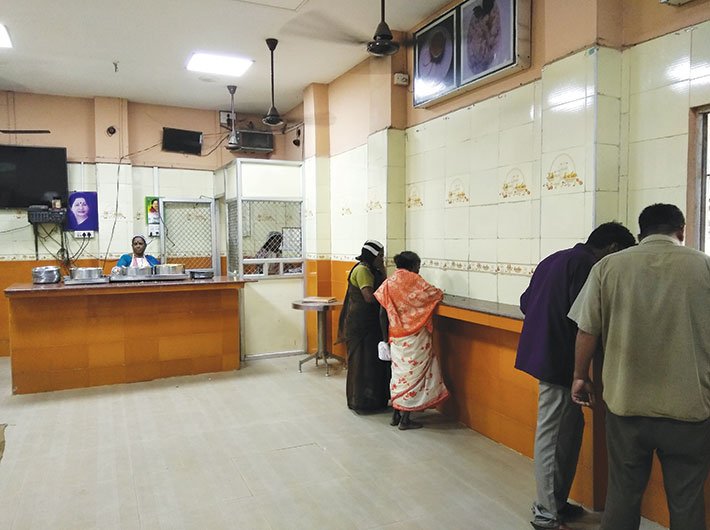Amma canteens are no longer the hits they were. Governance too has taken a beating in Tamil Nadu
It’s 1 pm and the place is not crowded. The usual lunch hour rush and long queues are surprisingly missing from the Amma canteen in Santhome, Chennai. There is a murmur in the large, clean hall. The menu is still the same as in 2013, curd rice for '3, sambhar rice and curry-leaf rice for Rs 5 a serving. Rajathi and Violet Mary, wearing aprons and hairnets, are quietly working behind the counter. The food is well cooked and tastes just as it did when the canteen was started.
People from all walks of life: young working professionals, a middle-aged couple, auto drivers and migrant workers are enjoying their food at prices they find very affordable. A few are even having their meals sitting on the floor, despite the unoccupied tables. Murugan, an auto-driver, says, “Adding more variety to the menu would be good.”
But variety is not the only issue. Some say there has been a decline in the quality of food in many of these canteens since their launch in 2013, more so after the demise of Amma (as Jayalalithaa was popularly called).
There are over 600 Amma unavagams (the Tamil word for canteens) in 32 districts of Tamil Nadu. Till 2016, 407 such canteens came up in Chennai alone, including seven in the city’s government hospitals. Canteens in Chennai are run by the Chennai municipal corporation. These canteens feed almost two lakh people daily in Chennai alone. They are staffed by around 4,800 women from self-help groups.
Dr P Kuganantham, former Chennai city health officer, in a write-up in The Hindu, states that 90 percent of beggars in the city have been reduced in the past five years after the commencement of Amma canteens, as compared to 3,000 beggars the Chennai corporation counted and rehabilitated in 2010 in a massive drive. Dr Kuganantham was the city health officer of the Chennai corporation when the concept of Amma canteen was mooted in 2012.
The Amma canteen model was so successful that it was soon adopted in Karnataka and other neighbouring states. However, after the demise of AIADMK matriarch J Jayalalithaa in December last year, there has been a question mark over the sustainability of these canteens in Tamil Nadu. As per some unconfirmed reports, a couple of months ago, the Chennai corporation was exploring the possibility of bringing down the number of Amma canteens in the city due to a funds crunch.
Dr Kuganantham also admits that currently there are challenges before Amma canteens. The Chennai municipal corporation is spending money from revenue funds for running these canteens. But this cannot continue for long. “If the self-help group women take it only as a peoples’ movement, then it cannot survive. So there has to be a dedicated department, such as the women development corporation, under which these canteens should be brought. Not only this, if we have to sustain them, then we have to slightly raise the charges of food,” he says.
A state government officer says on condition of anonymity that had Jayalalithaa been alive, efforts would have been made to keep the canteens flourishing. Officers are not enthusiastic about keeping the Amma canteen model alive. Amma canteens are running losses, he says.
Not just Amma canteens, but there has been a change in the overall governance system of Tamil Nadu. Like people’s comment on the quality of food at the canteens, some bureaucrats believe that governance has improved, others say it has deteriorated.
A senior bureaucrat in the government says, “Now, there is nobody to control things. The present chief minister [Palaniswami] is good but not assertive. He is not authoritative. Now, even officials are not taking things seriously. Today big policy decisions are not being taken.” Moreover, in the last five years, the government functioned in such a manner that no major progress was made in the state. Only day-to-day things were managed. Today, the government is ready but does not have a vision, he adds.
Another senior officer in the state government says, “At present, officers themselves are lost, especially on policy issues. Given the political situation, everyone is waiting for something to solidify. We used to be the number one state on many parameters. But in the past five years many other states have done a lot. At present, we don’t even have an active chief minister. We are lost and confused. No new policies or schemes are there. If we remain slumbering for another four to five years, other states will go ahead.” He adds, that earlier, the chief minister was commanding and decisions centred on one person.
Another senior bureaucrat, on the other hand, thinks that the current chief minister is accessible and decision making at the chief minister level is fast now. Files get cleared quickly. Now, even ministers are free to take decisions. Earlier, due to fear, the ministers did not even sit comfortably on their chairs; they used to sit on the edge of their chair, the bureaucrat says.
Ramu Manivannan, head of the department of politics and public administration, Madras university, feels that there is no political master now. Bureaucrats feel they are free. But this is not good for governance. There should be some political direction.
Governance has certainly changed after Amma. Some officers are breathing free and taking decisions, while some feel there is no central figure whom they can look up to.
On the one hand there is decentralisation now, but on the other, the culture of hero worshipping or cult worshipping has gone from governance matters. It seems the personality cult-driven governance died with Amma.
shivani@governancenow.com
(The article appears in the February 15, 2018 issue)

